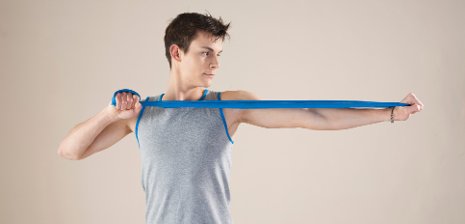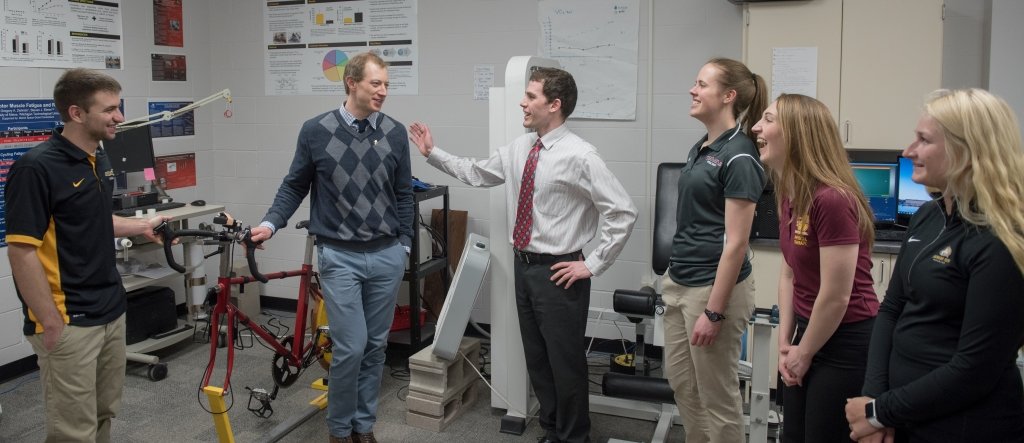Getting Physical Therapy Patients Moving

How do you get physical therapy patients to actually do their exercises when nobody is watching? A Michigan Technological University researcher and his graduate students might have found a way to get more rehabbing people up and moving.
Philart Jeon, assistant professor of cognitive and learning sciences (CLS), oversaw a class project focused on physical therapy patient compliance. The CLS students, who will present their research at the Human Factors and Ergonomics Society International Meeting in San Diego this fall, were Katrina Ellis, a PhD student, and Chad Norman and Alex Van der Merwe, Master of Science students.
One of their findings is no surprise.
“Patients are not likely to follow their instructions at home for a variety of reasons: lack of time and feedback, a feeling of helplessness,” Jeon says.
To begin their study, Jeon and his graduate students surveyed practicing physical therapists, physical therapy patients and undergraduate students to understand physical therapy practices, instructional materials and compliance tracking.
In this initial needs analysis survey, the patients and therapists “clearly expressed that it would be beneficial to have a video conference in between face-to-face meetings and if they use video instructions,” Jeon says.
However, current practices do not reflect this need. No therapist mentioned using video instructions, and only one patient reported following video instructions so far, Jeon says.
Next, the graduate students looked at how to help alleviate the problems patients have complying with instructions.
Using 58 undergraduates in their study, they looked at five different delivery methods of current instruction materials: video only, video and text, text only, pictures and text, and pictures only.
After viewing the different options, the students filled out a satisfaction survey
that included the following questions:
• Anxiety: How anxious would you feel to perform these exercises unsupervised?
• Satisfaction: How satisfied are you with the information you have been provided
by the physical therapist?
• Willingness: How willing would you be to perform these exercises unsupervised?
The undergraduates were then randomly assigned one of five mock physical conditions with information on two prescribed exercises, using one of the five methods. The students then answered twelve questions on what the researchers call "exercise self-efficacy"(ESE).
Previous research indicated that individuals with high ESE would exhibit more willingness to comply, Jeon said. However, in this study, that wasn’t necessarily true.
Instead, some interesting trends emerged, especially in relation to the methods of instructional delivery.
“The video and text instructions received the highest satisfaction rating,” Jeon said. “This group also had relatively high ratings in compliance and low ratings in anxiety.” Those who received just picture instructions or just text instructions were less satisfied.
These results support the benefits of adding video in physical therapy instructions, the researcher said. A willingness to do the therapy was also evident among the students using video and text instruction. Anxiety or compliance seemed less impacted by the various instructional methods.
An over-arching trend also surfaced: The higher the willingness to comply, the lower the anxiety. And, most importantly, video instruction may increase compliance, which will contribute to faster recovery for physical therapy patients, he said.
And one seemingly obvious question arose from the study: Would a mobile app be a better medium? Would video instruction and text via smart phone or tablet inspire even more people to get off the couch and do their exercises?
For that research, Jeon said he would like to use real patients and to check out the app.
“Just as there is difference between instruction media—video, photo, text, etc.” he said, “devices can make huge difference in terms of patients' compliance due to flexibility, mobility, accessibility, and so on. How we can design the instruction page differently depending on the device would involve another design research area: human-computer interaction research.”
Michigan Technological University is an R1 public research university founded in 1885 in Houghton, and is home to nearly 7,500 students from more than 60 countries around the world. Consistently ranked among the best universities in the country for return on investment, Michigan's flagship technological university offers more than 120 undergraduate and graduate degree programs in science and technology, engineering, computing, forestry, business, health professions, humanities, mathematics, social sciences, and the arts. The rural campus is situated just miles from Lake Superior in Michigan's Upper Peninsula, offering year-round opportunities for outdoor adventure.




Comments